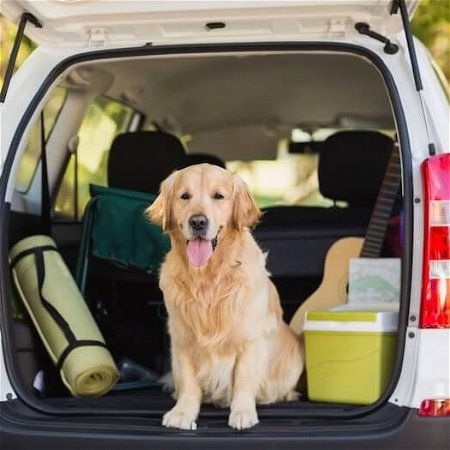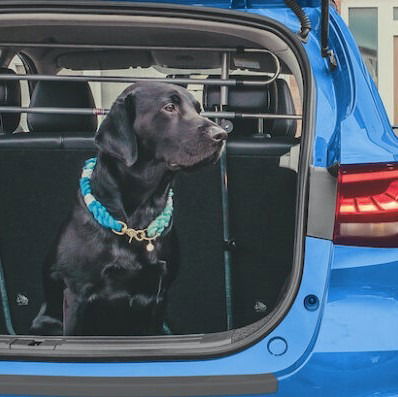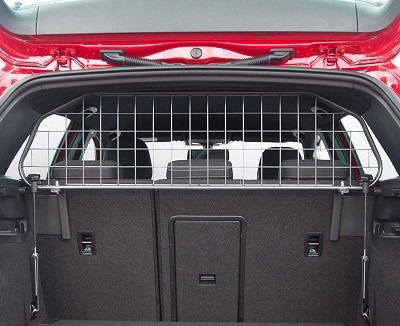The Dog Car Travel Guide
The Dog Car Travel Guide
It is estimated that over 3.2 million households in the UK have acquired a pet since the start of the pandemic. For some, life in lockdown has meant they can finally get the dog they have always dreamed of owning. More time at home means that many of us have had the time to train our dogs. But since we've all had to stay local, few dogs will have had the chance to get out and about in the car. With many choosing to stay and explore the UK for their holidays, more people are now traveling with their pets. Although many dogs will adapt to car travel with no problems, some will need a bit more time to get used to it. So if you are starting to get your four-legged friend used to travelling in your car, hopefully, you will find this article has plenty of tips and advice on how to travel with your dog safely in the car


Securing a Dog for Safer Travel
To keep your pet safer on car journeys and to ensure that you comply with the Highway Code regulations, you should use make sure the dog is secure in your vehicle. Fortunately, there are a range of options available to keep your pet safe on the move.
A dog crate
A dog crate provides a safe, enclosed space for your dog to travel in comfort. A dog crate can be useful for nervous travellers, especially if they are crate trained in the home, as the idea of having a safe space will already be familiar to them. You can line it with their favourite blanket or pop in their favourite toy on any journeys to help them feel more relaxed. You should choose a crate that is the right size for your dog, giving them enough space to sit, stand, and turn around in, yet be small enough to keep them secure. The crate should be a sturdy material and easy for you to use. Dog crates can seem quite bulky in your boot, and while many people choose to carry it permanently in the boot, you do have the flexibility to remove it should you need to.
Dog Carrier
For smaller dogs, a crate may be too big, and the better option may be to use a dog carrier. Carriers tend to be lighter weight than crates and can even be made from fabric. Each carrier will have instructions on the best way to secure them in the car, but many are best secured on the rear seats using the seatbelt. Some carriers can also double up as a bed if you are heading on a stay away from home, thereby reducing the amount of stuff you need to carry for your dog.

Dog Seat belt for cars
An option for large and small dogs is a dog car seatbelt which helps keep your dog secure if travelling them on the back seat. They come in all shapes and sizes, so it is easy to find a dog seatbelt that suits both yourself and your dog. Most dog seatbelts are harnesses that you fasten around your dog and then attach to the car to keep your pet safe when travelling. Some dog seatbelts will clip in to tether points in the car, while others will require you to thread it through the seatbelt.
Boot Guard
For people who want to put their dog in the boot, having a boot guard fitted is one of the most hassle-free solutions. You can buy and fit the guard yourself or have it fitted for you at a garage. Many manufacturers have dog guards available for specific models. A dog guard will help keep your dog secure in the boot and prevent it from getting loose. However, unlike a crate it doesn't take up space in the boot, so you can easily carry other luggage when your dog is not in the vehicle.

Getting a Dog Used to Car Travel
The best way to get your dog used to car travel is to start by getting them used to the car. You could get them to sit in the boot (if this is where they will be travelling) for short periods and feed them a couple of treats. As they get used to this, you can shut the boot and get in the driver's seat for short periods. Once the dog is comfortable getting in and out of the car and sitting in it for some time, you can start making very short journeys. You should start as you mean to go on, and introduce the method you will use to secure your dog in the car from the start. The earlier you can do this and the more consistent you are, the better they will accept it. To provide some reassurance, travel your dog with one of their blankets, their bed or a favourite toy. If possible, it is a good idea to go to fun places with your dog. For example, instead of walking to your local park, you could take your dog in the car. Doing this will help your dog associate car travel with a positive outcome. Once you have got out and about locally, you can increase the amount of time the dog spends in the car. Break up longer journeys by making regular stops and giving your dog a short walk. While most dogs quickly get used to travelling, some dogs do not adapt quite as well. Below we take a look at dog travel sickness and how you can help.
Dog Travel Sickness For owners with a pet with travel sickness travelling in the car can quickly become a worrying and unpleasant experience. Typical symptoms of dog travel sickness include:
- Whining and pacing
- Excessive drooling
- Smacking or licking lips
- Lethargy or inactivity
- Vomiting
- Diarrhoea
If your dog exhibits any of these signs, it may indicate they are not comfortable travelling in the car. Although it may be tempting to stop taking your dog in the car, this is not the best solution as they are likely to be times, for example, a visit to the vets, where a trip in the car can't be avoided.
For dogs who struggle with travel, there are various anti-sickness or anxiety medications available to help. Before buying, it is worth speaking to your vet or a dog behaviourist to get some advice on the best treatment for your dog.
Now you know a bit more about the best ways to ensure your dog travels safely in the car, it is time to look at some travel dos and don'ts.
Pet Travel Dos
- Ensure your dog is secured in the car using one of the methods discussed above to keep both you and your dog safer.
- Get your dog used to travelling in the car by starting with short trips and gradually build up the time your dog spends in the car.
- Take your dog to different places and not just places they may have negative associations with, like the vets.
- Drive smoothly, taking care when accelerating, braking and manoeuvring.
- Let your dog take their favourite toy or use their blanket, so they have something familiar with them when they first start travelling.
- Always have plenty of water available - it is worth investing in a spill-proof bowl to prevent a mess.
- Think about the temperature of the car on your journey. If it's hot, turn on the air-con to help keep your dog cool. If it is cold, you can pop a blanket over your dog as this allows them to get out from under it if they start to get too warm.
- On longer journeys, make regular stops in a safe place and give your dogs the chance to stretch their legs.
- Keep a pet first-aid kit in your car with basics like bandages, cotton wool, tweezers and round-ended scissors just in case anything should happen while you are out and about.
- Get your dog used to waiting in the car while you clip on their lead.
Pet Travel Don'ts
- Don't let your dog travel in the car loose, as this poses a risk to you and other road users and could result in a fine and points on your licence.
- Don't feed your dog just before travelling - feed them at least two hours before you plan to travel. If setting off early, it may be best to skip breakfast and feed once you have arrived at your destination.
- Don't let your dog jump out of the car as soon as you arrive - get them used to sitting and waiting in the car while you clip their leads on and encourage them to stay calm.
- Don't travel non-stop to get to your destination quicker if you are heading on a long journey.
- Don't leave your dog unattended in a car, especially in hot weather.
